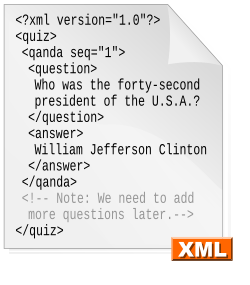markup language by the W3C for encoding of data From Wikipedia, the free encyclopedia
The Extensible Markup Language (short XML) is a markup language like HTML but is extensible.[3] It's created by the World Wide Web Consortium (W3C). XML defines rules for the construction of a document. XML adds context to the information in a document. It does not say how this should be displayed.
 | |
| Filename extension | .xml |
|---|---|
| Internet media type | |
| Uniform Type Identifier (UTI) | public.xml |
| UTI conformation | public.text |
| Developed by | World Wide Web Consortium |
| Type of format | Markup language |
| Extended from | SGML |
| Extended to | Numerous, including: XHTML, RSS, Atom, KML |
| Standard | 1.0 (Fifth Edition) November 26, 2008 1.1 (Second Edition) August 16, 2006 |
| Open format? | Yes |
Some programs get information out of an XML-document. To do that, they need an API.[4] There are many APIs for XML.
You can write a description of an XML document in a way that is useful for programmers. There are several languages for this; the best known is called DTD.
Code!
XML uses less than (<) and greater than (>) to show tags. For example, a paragraph in HTML would be <p>.
A closing tag is a tag used to enclose the value of the tag. The tag has a slash (/) before its name. For example, </p>
A tag which is empty can be represented as an opening tag but with a slash before the >. For example, <p/>
The XML specification defines a valid XML document as a well-formed XML document which also conforms to the rules of a Document Type Definition (DTD).[5][6]
The following languages are based on XML.
There are a lot more languages that use XML. A couple of them are:
Seamless Wikipedia browsing. On steroids.
Every time you click a link to Wikipedia, Wiktionary or Wikiquote in your browser's search results, it will show the modern Wikiwand interface.
Wikiwand extension is a five stars, simple, with minimum permission required to keep your browsing private, safe and transparent.